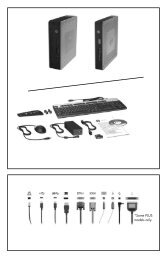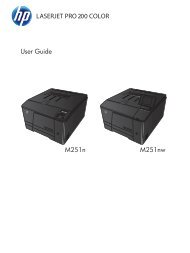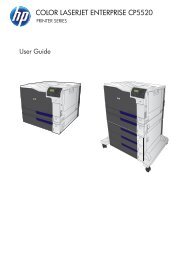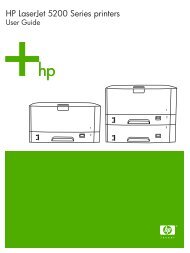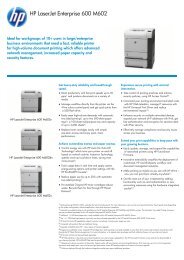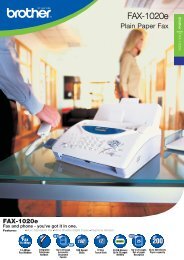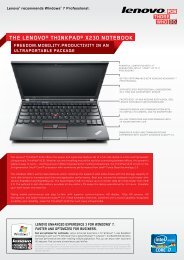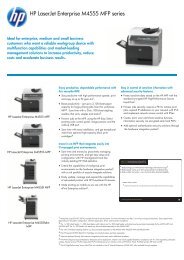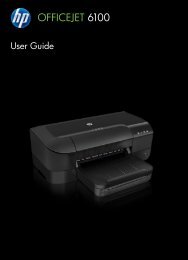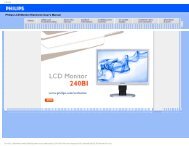User Manual
User Manual
User Manual
Create successful ePaper yourself
Turn your PDF publications into a flip-book with our unique Google optimized e-Paper software.
1. From the Windows desktop, click Start ➙ All Programs ➙ Lenovo ThinkVantage Tools ➙ Enhanced<br />
Backup and Restore. The Rescue and Recovery program opens.<br />
2. In the Rescue and Recovery main window, click the Launch advanced Rescue and Recovery arrow.<br />
3. Click Back up your hard drive and select backup operation options. Then, follow the instructions on<br />
the screen to complete the backup operation.<br />
Performing a recovery operation<br />
This section provides instructions on how to perform a recovery operation using the Rescue and Recovery<br />
program.<br />
To perform a recovery operation using the Rescue and Recovery program on the Windows 7 operating<br />
system, do the following:<br />
1. From the Windows desktop, click Start ➙ All Programs ➙ Lenovo ThinkVantage Tools ➙ Enhanced<br />
Backup and Restore. The Rescue and Recovery program opens.<br />
2. In the Rescue and Recovery main window, click the Launch advanced Rescue and Recovery arrow.<br />
3. Click the Restore your system from a backup icon.<br />
4. Follow the instructions on the screen to complete the recovery operation.<br />
For more information about performing a recovery operation from the Rescue and Recovery workspace, see<br />
“Using the Rescue and Recovery workspace” on page 39.<br />
Using the Rescue and Recovery workspace<br />
The Rescue and Recovery workspace resides in a protected, hidden area of your hard disk drive that<br />
operates independently from the Windows operating system. This enables you to perform recovery<br />
operations even if you cannot start the Windows operating system. You can perform the following recovery<br />
operations from the Rescue and Recovery workspace:<br />
• Rescue files from your hard disk drive or from a backup: The Rescue and Recovery workspace enables<br />
you to locate files on your hard disk drive and transfer them to a network drive or other recordable media,<br />
such as a USB device or a disc. This solution is available even if you did not back up your files or if<br />
changes were made to the files since your last backup operation. You can also rescue individual files from<br />
a Rescue and Recovery backup located on your local hard disk drive, a USB device, or a network drive.<br />
• Restore your hard disk drive from a Rescue and Recovery backup: If you have backed up your hard disk<br />
drive using the Rescue and Recovery program, you can restore the hard disk drive from a Rescue and<br />
Recovery backup, even if you cannot start the Windows operating system.<br />
• Restore your hard disk drive to the factory default state: The Rescue and Recovery workspace enables<br />
you to restore the complete contents of your hard disk drive to the factory default state. If you have<br />
multiple partitions on your hard disk drive, you have the option to restore the C: partition and leave the<br />
other partitions intact. Because the Rescue and Recovery workspace operates independently from<br />
the Windows operating system, you can restore the hard disk drive to the factory default state even if<br />
you cannot start the Windows operating system.<br />
Attention: If you restore the hard disk drive from a Rescue and Recovery backup or restore the hard disk<br />
drive to the factory default settings, all files on the primary hard disk drive partition (usually drive C:) will be<br />
deleted in the recovery process. If possible, make copies of important files. If you are unable to start the<br />
Windows operating system, you can use the rescue files feature of the Rescue and Recovery workspace to<br />
copy files from your hard disk drive to other media.<br />
To start the Rescue and Recovery workspace, do the following:<br />
1. Make sure the computer is turned off.<br />
Chapter 6. Recovery information 39



